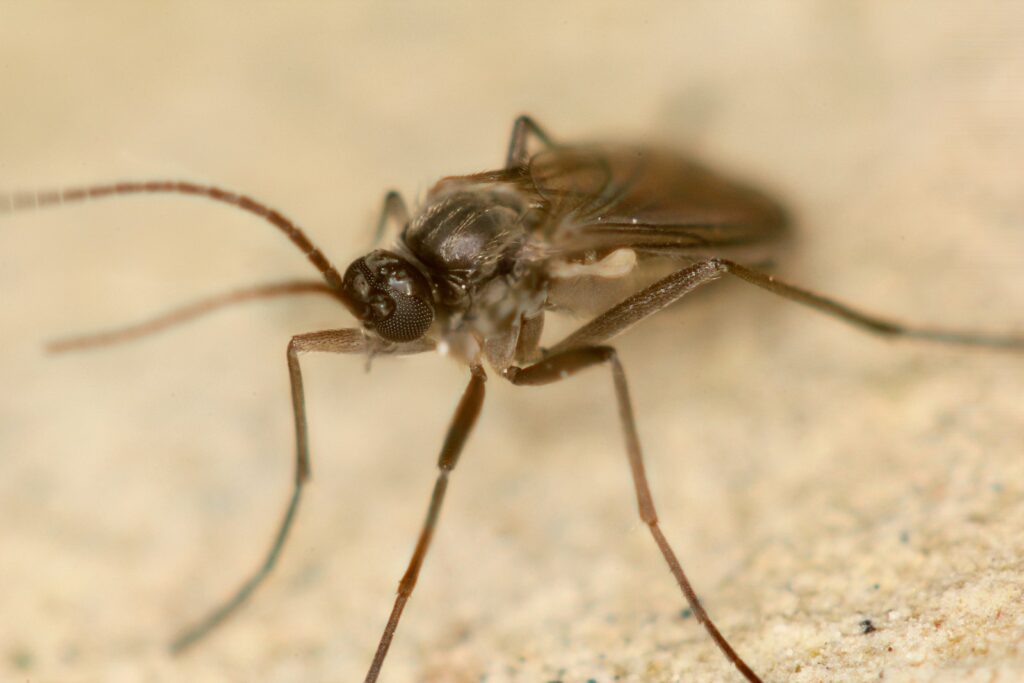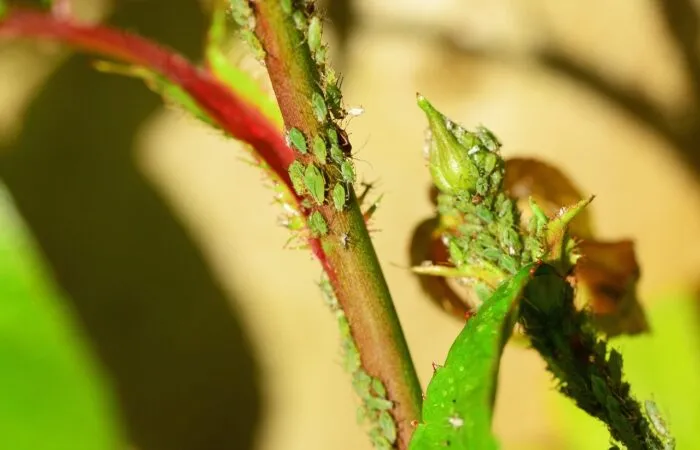How to get rid of fungus gnats & sciarid flies from house plants
 Lee Burkhill: Award Winning Designer & BBC 1's Garden Rescue Presenters Official Blog
Lee Burkhill: Award Winning Designer & BBC 1's Garden Rescue Presenters Official Blog

Getting rid of fungus gnats can be a perpetual headache for house plant owners. These tiny flies quickly disrupt the serene green oasis of our indoor space house plants. These tiny, flying pests may be diminutive in size, but their impact is disproportionately felt.
Funga gnat larvae feast on plant roots and organic matter in damp soil, damaging your houseplants. Leaving house plants weakened to other pests. Fungus gnats also have an annoying habit of flying around your face when you're trying to work from home or relax on the sofa!
This page contains affiliate links for products I use and love. If you take action (i.e., subscribe or make a purchase) after clicking a link, I may earn some gardening commission, which helps me keep the Garden Ninja Blog free for all.
If so, meet the party crashers of the plant world – fungus gnats!

These tiny, winged intruders are like the unruly guests who show up uninvited when you start looking after houseplants. Picture them as the little daredevils of the insect realm, always ready for a wild flight around your favourite houseplants and into your face when you try to relax on the sofa.
These minuscule flies have a particular affinity for damp soil, and they're the unapologetic fans of overwatering – a bit like your forgetful friend who always spills their drink at gatherings. With a penchant for organic debris, they're like tiny connoisseurs of decay, turning your plant pots into their version of a five-star restaurant. Without treatment, fungus gnats can become a real problem.

Fungus gnats (Sciarid flies) are small, flying insects commonly found in and around indoor plants. These pests are primarily attracted to damp, organic-rich environments, and several factors contribute to the presence of fungus gnats:
Fungus gnats thrive in moist conditions, and overwatering indoor plants creates a suitable habitat for their larvae. Excessively wet soil provides an ideal breeding ground for fungus gnat larvae.
The larvae of fungus gnats feed on fungi, organic matter, and plant roots in damp soil. If the soil remains consistently moist, it promotes the development of fungus and organic debris, attracting these pests.

So, if you've been giving 'too much love' in the form of hydration to your house plants, you may need to cut back. Very few house plants actually like or need constantly wet soil.
Did you know that you can take my online gardening course and learn how to become a Garden Ninja yourself? Click here for details
Fungus gnats are attracted to decaying organic matter, such as fallen leaves or decomposing plant material in the soil. The presence of organic debris provides a food source for both adult gnats and their larvae. This is why peat-free or organic composts are usually prime growing material for fungus gnats; they thrive on the richness of this type of growing media!
Planters that are overcrowded with plants can create poor air circulation and contribute to moisture retention in the soil. This creates favourable conditions again for fungus gnats to thrive. So, less is more when it comes to packing those containers with plants!

Buying plants unwittingly that already have fungus gnats is one of the biggest causes of them. Fungus gnats may be introduced to your indoor environment through the purchase of infested plants right under your nose! Larvae or eggs could be present in the soil of newly acquired plants, leading to an infestation.
There's little you can do to check when buying plants online, but when buying houseplants in garden centres, give the plant a little shake, and if lots of flies emerge, then put it back and move on.

Poor drainage in plant containers can lead to waterlogged soil, creating an environment suitable for fungus gnat larvae to feast on organic matter and house plant roots. Providing adequate drainage, such as saucers under pots with draining holes, helps prevent excessive moisture and reduces the risk of infestations.
Avoid planting in completely sealed pots. Always choose a house plant pot with a built-in reservoir or drainage holes in the bottom for this reason.
There are a few tried and tested methods to eliminate pesky fungus gnats so your house plants can thrive and not be harmed by the larvae nibbling on their roots.
In my experience, it's always best to use a mixture of these treatments as fungus gnats are notoriously resilient, and sciarid flies can take around a month to get rid of fully. This is due to the 30-plus day's life cycle from egg to adult.
Sticky fungus gnat fly traps are the first port of call when dealing with tiny house flies invading your plants and personal space. They are a cost-effective way of stopping the adults from laying eggs in your house plant pots and compost.
The beauty of sticky traps for sciarid flies is that they are completely harmless to pets and children, other than sticking to their fur or hands if they grab them.
The way that sticky traps work is to disrupt the lifecycle and reproduction of fungus gnats. So the more adult flies you catch, the fewer eggs and fungus gnat larvae there are in the plants growing media.

However, sticky traps alone will not completely eradicate fungus gnats or sciarid flies from your plants. This is because it only takes a few adults to avoid the traps to keep the lifecycle going.
Sticky traps will reduce the number of fungus gnats but not completely eradicate them on their own. However, they are a cheap and cheerful part of the solution, with sticky traps usually costing only a few pounds or dollars.
Aim to replace sticky traps each week or when full of dead adult sciarid flies.
Horticultural gravel mulch is the second defence against fungus gnats. This gravel mulch makes it far harder for the adult flies to lay their eggs in the compost of your house plants. Given how tiny the flies are, they are simply not big or strong enough to move the gravel out of the way.

The one thing you need to make sure, though, is that the entire surface of the compost or house plant is covered. If there is a gap then adult flies will soon find it and start laying there instead.
Use a fine horticultural grit like this for perfect coverage and banish those pesky fungus gnat flies from laying eggs in your house plants.
The third option to rid yourself of sciarid flies and fungus gnats is a clever biological control solution by using Bti (Bacillus thuringiensis subspecies israelensis), also known as bacteria tablets, which are then watered into the soil.
Bacteria tablets, specifically those containing the beneficial bacterium Bacillus thuringiensis subspecies israelensis (Bti), are often used to control fungus gnat larvae in the soil.

Bacteria tablets work to target and kill fungus gnats by adding Bti, a natural insecticide, to the soil. Bti is a naturally occurring bacterium found in soil. It is commonly used as a biological insecticide due to its efficacy against certain insect larvae, including fungus gnat larvae. Bti is harmless to humans, pets, and plants, making it an environmentally friendly option for pest control.
When the larvae of fungus gnats come into contact with the Bti, the bacteria produce toxins that specifically target the larvae's digestive system. The toxins disrupt the gut cells of the fungus gnat larvae, leading to their paralysis and eventual death.
One of the key advantages of using Bti is its selective toxicity. It primarily affects the larvae of specific insect groups, such as mosquitoes and fungus gnats, while being harmless to other beneficial insects, plants, and animals.
The one drawback with bacteria tablets (Bti) is they are relatively expensive to use and take a while to build up in the soil of your house plants. I only use them with really heavy infestations.
If you thought bacteria tablets were impressive, then wait until you discover an army of soil-dwelling larvae munchers: the nematodes!
Nematodes, specifically beneficial nematodes like Steinernema feltiae, are microscopic organisms that play a crucial role in natural pest control, including managing fungus gnats. When applied to the soil, these tiny roundworms actively seek out and parasitize the larvae of various soil-dwelling pests, such as fungus gnats.

Upon locating a host larva, the nematodes enter the larva's body cavity and release bacteria, which quickly multiply and cause septicemia, leading to the death of the pest. The nematodes then feed on the liquefied contents of the deceased larva and reproduce, continuing their cycle of biological pest control.

Using nematodes for sciarid flies is both environmentally friendly and highly effective, as beneficial nematodes provide a targeted and natural solution for managing pest populations in the soil without harming beneficial organisms, plants, or the environment.
If soil-dwelling assassins are not your thing when it comes to getting rid of sciarid flies, then neem powder could be the solution for you. Neem powder can be applied to the plants as a mulch on the top layer of soil or if mixed with water and then used as a drench.

Neem powder, derived from the leaves of the neem tree (Azadirachta indica), is a biological fungus gnat killer which is 100% organic. Neem powder works effectively in pest control by disrupting the growth and development of insect pests, particularly through the compound azadirachtin. Additionally, its strong odour and bitter taste act as a natural repellent, deterring insects from treated areas.
The one drawback of neem powder is the smell. It has an aroma of burnt coffee and leaves with a pungent, bitter top note. This is why a lot of people water it in rather than have it as a mulch. I used it in my home garden design studio, and the smell was very offputting!
A cheap and cheerful biological control method for fungus gnats is using ground cinnamon around the base of the plants. The strong odour puts off the adult flies, who will avoid laying their eggs near this herb. Cinnamon is an easy, ethical way of deterring adult flies, but it sadly won't stop any larvae that are in the soil. Also, when you water the plant, you must keep reapplying cinnamon, so the costs can soon add up.

It is important to understand the life cycle of fungus gnats to know how to get rid of them for good! By understanding how long each of the stages of their growth lasts, you can work out which treatment to use.
The lifecycle of fungus gnats (Sciaridae family) consists of four main stages:
Understanding these stages is crucial for effective control and prevention. Here's a breakdown of the fungus gnat lifecycle:
The fungus gnat lifecycle begins with the female laying tiny, transparent eggs in the top layer of moist soil. These eggs are often deposited near organic matter, such as decaying plant material or fungi. The eggs hatch within a week, depending on environmental conditions.
Once the eggs hatch, the larvae emerge. Fungus gnat larvae are slender, legless, and transparent, with a black head. They have a voracious appetite for organic matter, fungi, and plant roots, which they feed on in the top layer of the soil. This stage is the most damaging to plants as the larvae can cause root damage. The larval stage typically lasts for about two to three weeks.

As the larvae mature, they enter the pupa stage. During this stage, the larvae transform into pupae, cocooned within silk-like threads in the soil. The pupa stage usually lasts for a week or two, and it is a transitional phase leading to the emergence of adult fungus gnats.
The final stage of the lifecycle is the emergence of adult fungus gnats. The tiny, mosquito-like adults have long legs, segmented antennae, and a characteristic Y-shaped vein in their wings. They are most active during the evening and are attracted to light. The primary purpose of the adult stage is reproduction. Adult fungus gnats live for about one to two weeks, during which they lay eggs to restart the lifecycle.

In my professional experience, the best treatment for fungus gnats or sciarid flies is sticky traps and nematodes as a joint solution. By using both of these methods of eradicating fungus gnats, you can usually remove them within 1-2 weeks.
The problems with the other treatments are either their accuracy in killing fungus gnats or the smell/fuss factor. Obviously, pick whichever treatments meet your budget and preference, but you will need at least two different treatments to remove the adults and kill the eggs or larvae.
Here is a step-by-step guide on how to use beneficial nematodes for controlling fungus gnats:
Obtain beneficial nematodes specifically formulated for controlling fungus gnats. These microscopic organisms, often species like Steinernema feltiae, are available for purchase from gardening supply stores.
Before use, check the storage conditions and the expiry date of the beneficial nematodes to ensure their viability.

Follow the instructions on the product packaging to prepare the nematode solution. This may involve mixing the nematodes with water. Use clean, non-chlorinated water for best results.
As a rule of thumb, it's usually 1 packet of 5 million nematodes per 10 litres of water (one watering can). This will treat 10 square meters of coverage.
Don't try to save or split the nematode packet. Use them all at once.
Before applying the nematode solution, water the soil around the affected plants. This helps create a favourable environment for the nematodes and ensures that the soil is moist. This step is essential to kill of fungus gnats!
Using a watering can or sprayer, apply the nematode solution to the soil around the base of the affected plants. Ensure even coverage, focusing on areas with known fungus gnat activity. Drench the soil with the solution.

Water the soil lightly again after applying the nematode solution. This helps the nematodes penetrate the soil and reach the fungus gnat larvae effectively.
Maintain regular watering practices to keep the soil consistently moist. Beneficial nematodes work best in a damp environment.
Regularly monitor the affected plants for any signs of fungus gnat larvae or adult activity. If necessary, reapply the nematodes according to the recommended frequency on the product label. If you still see fungus gnats or flies after 4 weeks, then reapply.
Here are step-by-step instructions for using Bacillus thuringiensis subspecies israelensis (Bti) tablets to control fungus gnats:
Select Bti tablets specifically formulated for controlling fungus gnats. These tablets typically contain the beneficial bacterium Bacillus thuringiensis subspecies israelensis. Carefully read and follow the instructions on the product label provided by the manufacturer. Pay attention to dosage recommendations, application frequency, and any safety precautions.

Most Bti tablets may need to be dissolved or mixed with water before application. Follow the specific preparation instructions provided on the product label. Usually, it's 1 bacteria tablet per 10 liters of water (a standard watering can).
Water the solution directly onto the soil surface in the affected areas. Ensure even distribution, especially around the base of plants where larvae are likely to be present. Make sure the entire surface of the soil is covered and wet from the drench mix.

Regularly monitor the affected plants and observe the population of fungus gnat larvae. If needed, reapply the Bti tablets according to the recommended frequency outlined in the product instructions. Usually, reapply every 2-3 weeks until the fungus gnats have gone.
Getting rid of fungus gnats is like giving your plants a spa day – it's a treat that boosts their well-being! These tiny pests may be small, but their larvae can wreak havoc on your plant's roots, hindering growth and vitality. By bidding farewell to fungus gnats, you create a stress-free environment for your leafy companions. It also means no more annoying flies buzzing around your face when you're trying to relax or design a garden!
If you have questions or comments why not let me know below? You can Tweet, Facebook or Instagram me. You can also follow me on Youtube where I’ve got plenty of garden guide vlogs!








JOIN THE NINJAS

Be the first in line for new Guides, Discount codes and Offers